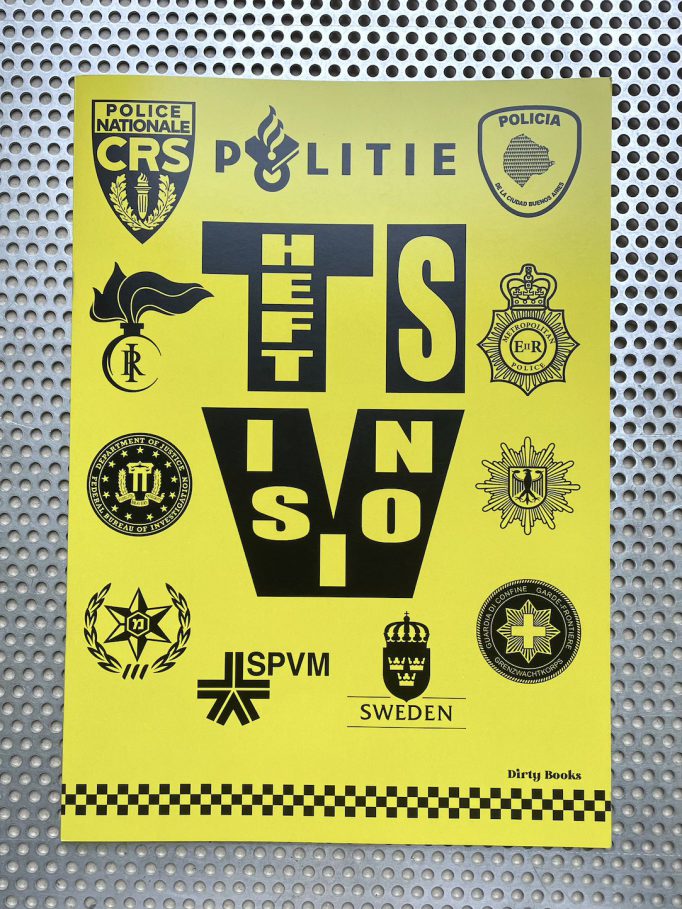Theft is Vision – Dirty Books. Dan Mitchell. Edition Patrick Frey
Posted in photography on November 3rd, 2023Tags: art, Artist by Artist, collage, Dan Mitchell, Edition Patrick Frey, erotic, lolz style, meme, photography, porn, posters, Theft is Vision - Dirty books








The works in this publication were commissioned by Fredi Fischli and Niels Olsen. I was asked to remake each of artist’s work as ‘posters’, with the direction that they should be at least 85% ‘Dan Mitchell’. The joke was to appropriate the appropriators. Additionally I included, as subjects, the architect of the show’s design, Petra Blaisse / Inside Outside, and also the curators themselves.
Things got a little confusing between 2020 and 2021 as there were 3 book projects on the go at the same time – the official catalogue for Theft is Vision, the book ‘Dan Mitchell Posters’* (both designed by Teo Schifferli and an unofficial lolz style book/ catalogue of the posters now published here. Only the book of my posters made it to print. Cultural fashion shifts and Covid put paid to the desire to produce a physical publication, appropriation, as a subject didn’t seem to be cool anymore.
Pocket Guide: Dan Mitchell Posters
With: Casima von Bonin. Maurizio Cattelan, Maria Eichhorn, Marie Louise Eman, Syvie Fleury, Isa Genzken, Richard Hamilton, Charline von Hey, Pierre Joseph, Valentina Liernur, Dan Mitchell, Mathieu Malouf, Malcolm Morley, Albert Oehlen, Betty Tompkins and Gili Tal.
Exhibition architecture by Petra Blaise / Inside Outside
The notion of ‘Theft’ establishes a site of investigation. This exhibition examines the desire to appropriate – a fundamental theme in the production of art. Throughout art there are typologies that ensue from the appropriation of motifs or of other works of art. As just one form of aggressive theft, the act of citation was already a cultural strategy long before Appropriation Art manifested itself.
At Luma Westbau the following questions are posed from a contemporary perspective:
What are the genres established through appropriation today? What does stealing mean for artistic production? Is it an act of removal and subtraction? Or can it be a productive strategy as suggested by the art history of Appropriation Art? In the context of this exhibition, ‘Theft is presented as dialogues and translations between artists. In essence, the exhibition confronts two opposing concepts in appropriation: the desire to appropriate as the idolization of sources or as an attack on and subversion of the established.
The typology of the enfilade a suite of rooms in grand architecture – is reconfigured in translucent plastic inthe exhibition design by Petra Baisse / inside Outside and inserted into the White Cube spacent encloses formative typologies of works of art productively used by numerous artists. The investigation leads to a wild variety of iconic and unexpected results: reconfigurations of Marcel Duchamp’s readymades, Kazimir Malevich’s Black Square, Lucio Fontana’s Concetto Spaziale, Jasper John’s Target, Fra Angelico’s Annunciation, Jacques-Louis David’s Napoleon Crossing the Alps, book illustrations by Bernard Buffet, and Courbet’s L’Origine Du Mode or variations on shopping-bag installations. By gathering these typologies together, the exhibition reveals and contrasts different appropriation strategies in art, and invites to discern and encounter sources, counterparts, and sundry partners in crime.
Order here










